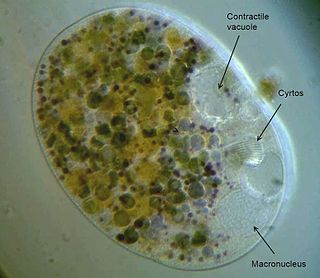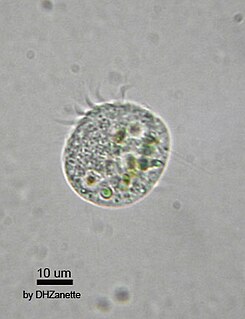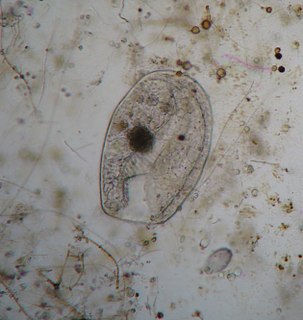
The heterotrichs are a class of ciliates. They typically have a prominent adoral zone of membranelles circling the mouth, used in locomotion and feeding, and shorter cilia on the rest of the body. Many species are highly contractile, and are typically compressed or conical in form. These include some of the largest protozoa, such as Stentor and Spirostomum, as well as many brightly pigmented forms, such as certain Blepharisma.
The plagiopylids are a small order of ciliates, including a few forms common in anaerobic habitats.

The Nassophorea are a class of ciliates. Members are free-living, usually in freshwater but also in marine and soil environments. The mouth is anterior ventral and leads to a curved cytopharynx supported by a prominent palisade of rods or nematodesmata, forming a structure called a cyrtos or nasse, typical of this and a few other classes. When present, extrusomes take the form of fibrous trichocysts. Cilia are usually monokinetids, but vary from order to order.

The peniculids are an order of ciliate protozoa, including the well-known Paramecium and related genera, such as Frontonia, Stokesia, Urocentrum and Lembadion. Most are relatively large, freshwater forms that feed by sweeping smaller organisms into the mouth. They have weird life cycles, and in many cases do not even form resting cysts.

The hymenostomes are an order of ciliate protozoa. Most are free-living in freshwater, such as the commonly studied genus Tetrahymena, but some are parasitic on fish or aquatic invertebrates. Among these is the important species Ichthyophthirius multifiliis, a common cause of death in aquaria and fish farms.

The Phyllopharyngea are a class of ciliates, including some which are extremely specialized. Motile cells typically have cilia restricted to the ventral surface, or some part thereof, arising from monokinetids with a characteristic ultrastructure. In both chonotrichs and suctoria, however, only newly formed cells are motile and the sessile adults have undergone considerable modifications of form and appearance. Chonotrichs, found mainly on crustaceans, are vase-shaped, with cilia restricted to a funnel leading down into the mouth. Mature suctorians lack cilia altogether, and initially were not classified as ciliates.

The Colpodea are a class of ciliates, of about 200 species common in freshwater and soil habitats. The body cilia are typically uniform, and are supported by dikinetids of characteristic structure, with cilia on both kinetosomes. The mouth may be apical or ventral, with more or less prominent associated polykinetids. Many are asymmetrical, the cells twisting sideways and then untwisting again prior to division, which often takes place within cysts. Colpoda, a kidney-shaped ciliate common in organic rich conditions, is representative.

The hypotrichs are a group of ciliated protozoa, common in fresh water, salt water, soil and moss. Hypotrichs possess compound ciliary organelles called "cirri," which are made up of thick tufts of cilia, sparsely distributed on the ventral surface of the cell. The multiple fused cilia which form a cirrus function together as a unit, enabling the organism to crawl along solid substrates such as submerged debris or sediments. Hypotrichs typically possess a large oral aperture, bordered on one side by a wreath or collar of membranelles, forming an "adoral zone of membranelles," or AZM.

The stichotrichs were a proposed group of ciliates, in the class Spirotrichea. In a classification system proposed by Eugene Small and Denis Lynn in 1985, Stichotrichia formed a subclass containing four orders: Stichotrichida, Urostylida, Sporadotrichida and Plagiotomida. Although the group was made up of species traditionally classified among the "hypotrichs"--ciliates possessing compound ciliary organelles called cirri--it excluded euplotid ciliates such as Euplotes and Diophrys, which were placed in the subclass Hypotrichia. In later classifications proposed by Denis Lynn, Stichotrichia omits the order Plagiotomida.

Holotricha is an order of ciliates. The classification has fallen from use as a formal taxon, but the terms "holotrich" and "holotrichous" are still applied descriptively to organisms with cilia of uniform length distributed evenly over the surface of the body.

Stylonychia is a genus of ciliates, in the subclass Hypotrichia. Species of Stylonychia are very common in fresh water and soil, and may be found on filamentous algae, surface films, and among particles of sediment. Stylonychia can also be found swimming on and through decaying vegetation and pond scum floating through the water. Like its relatives, Stylonychia has cilia grouped into membranelles alongside the mouth and cirri over the body. It is distinguished partly by long cirri at the posterior, usually a cluster of three. The largest can just be seen at a 25x magnification, and the smallest can just be seen at a 450x magnification. Members of the group are carnivorous and prey on other protozoans and bacteria.

The oligotrichs are a group of ciliates, included among the spirotrichs. They have prominent oral cilia, which are arranged as a collar and lapel, in contrast to the choreotrichs where they form a complete circle. The body cilia are reduced to a girdle and ventral cilia. In Halteria and its relatives, they form bristles or cirri; however these forms may be closer relatives of the stichotrichs than of other oligotrichs. These organisms are very common in plankton communities, especially in marine systems. Usually found in concentrations of about 1 per ml, they are the most important herbivores in the sea, the first link in the food chain.
Membranelles are structures found around the mouth, or cytostome, in ciliates. They are typically arranged in series, to form an "adoral zone of membranelles," or AZM, on the left side of the buccal cavity (peristome). The membranelles are made up of kinetosomes arranged in groups to make up polykinetids. The cilia which emerge from these structures appear to be fused and to function as a single membrane, which can be used to sweep particles of food into the cytostome, or for locomotion.

The ciliates are a group of protozoans characterized by the presence of hair-like organelles called cilia, which are identical in structure to eukaryotic flagella, but are in general shorter and present in much larger numbers, with a different undulating pattern than flagella. Cilia occur in all members of the group and are variously used in swimming, crawling, attachment, feeding, and sensation.

Euplotes is a genus of ciliates in the subclass Euplotia. Species are widely distributed in marine and freshwater environments, as well as soil and moss. Most members of the genus are free-living, but two species have been recorded as commensal organisms in the digestive tracts of sea urchins.
Halofolliculina corallasia is a species of heterotrich ciliates identified as a cause of the syndrome called skeletal eroding band (SEB). It is the first coral disease pathogen that is a protozoan as well as the first known to be a eucaryote; all others identified are bacteria. Like other members of the folliculinid family, H. corallasia is sessile and lives in a "house" called a lorica, into which the cell can retreat when disturbed. The mouth is flanked by a pair of wing-like projections that are fringed with polykinetids, groups of cilia that work in groups to produce a current that draws food into the "mouth".

Intramacronucleata is a subphylum of ciliates. The group is characterized by the manner in which division of the macronucleus is accomplished during binary fission of the cell. In ciliates of this subphylum, division of the macronucleus is achieved by the action of microtubules which are assembled inside the macronucleus itself. This is in contrast to heterotrich ciliates of the subphylum Postciliodesmatophora, in which division of the macronucleus relies on microtubules formed outside the macronuclear envelope.

Bursaria is a genus of ciliates in the class Colpodea. They are relatively large and feed on other protists in freshwater habitats.
Glaucoma is a genus of freshwater ciliates in the Oligohymenophorea. Cells in this genus are between 30–150 µm long, and have three membranelles that surround the oral cavity. Two of the membranelles are used to sweep water towards the mouth, while the third acts like a sieve to strain out food particles for ingestion. In contrast, many other filter-feeding oligohymenophoreans use the paroral membrane, also known as an undulating membrane, for this purpose, but the paroral is not well-developed in Glaucoma.
Halteria, sometimes referred to as the jumping oligotrich, is a genus of common planktonic ciliates that are found in many freshwater environments. Halteria are easy to locate due to their abundance and distinctive behaviour with observations of Halteria potentially dating back to the 17th century and the discovery of microorganisms. Over time more has been established about their morphology and behavior, which has led to many changes in terms of classification.















